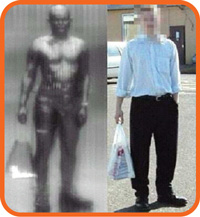
home | Who are we? | Workshop | Resources | Links | Gallery |
| Security |
When we take a normal photograph we usually see a contrast between objects due to the difference in the amount of light they reflect. That light typically comes from either the sun or sky (outdoors) or lightbulbs (indoors). In the image on the left, the right hand picture of the man is taken with a normal camera and the left hand picture is taken with a millimetre wave camera. It can see through the bag revealing the hidden gun.
These millimetre wave images show cold as white and hot as black. Outdoors the sky acts as a very cold floodlight which reflects off your head giving a strong contrast with our surroundings and a clear image. Indoors the head reflects the temperature of the room which is closer to our own temperature so there is little contrast and an indistinct image. X-ray machines are conventionally used to search for dangerous items and have been very successful in identifying knives, guns and other metal items in hand luggage. Metal detectors have been used to identify objects about a person and rely on detection of a mass of metal however their effectiveness depends on size of the object, the type of metal and its orientation. Also metal detectors, which detect magnetic field variation, cannot distinguish between metal objects such as belts or keys and threatening objects. As most of us have experienced, this can slow down the flow of people through security. With the increased threat of terrorism there is a need for more
effective techniques to detect hostile objects. Also modern weapons
include plastic or ceramic guns and plastic and liquid explosives,
all of which cannot be detected with conventional metal detectors.
Millimetre-wave security systems have been tested at many UK airports.
As the waves are effectively seeing through clothes this has posed
privacy issues. Would you mind someone looking through your clothes
for the sake of security? Improvements to the system mean that a
computer will be used to identify the objects rather than a human
behind a screen. Also it is important to remember that mm-waves
are intrinsically pixelated and so do not reveal the naked body
in detail.
|
'Vision For The Future' is an EPSRC funded project run by the MMW group at the University of St Andrews
Copyright ©2006 by the University of St Andrews :: web, graphic and exhibition design by FifeX Ltd, www.fifex.co.uk
 Millimetre
waves pass through clothing just like tv, radio and mobile phone
signals. Metal objects reflect strongly showing up in contrast to
the body. these two properties make millimetre wave imaging ideal
for security scanning.
Millimetre
waves pass through clothing just like tv, radio and mobile phone
signals. Metal objects reflect strongly showing up in contrast to
the body. these two properties make millimetre wave imaging ideal
for security scanning. Millimetre wave cameras see the heat in a scene and objects appear
at different temperatures depending on how much heat they emit or
how much they reflect the heat from the surroundings. Outdoors the
contrast is provided by the difference between the heat of warm
objects and reflections of the sky above which is very cold - 200°C
below freezing. indoors the contrast is much less since the temperatures
of objects and the room are similar, so an artificial mm-wave light
source is sometimes used to increase contrast.
Millimetre wave cameras see the heat in a scene and objects appear
at different temperatures depending on how much heat they emit or
how much they reflect the heat from the surroundings. Outdoors the
contrast is provided by the difference between the heat of warm
objects and reflections of the sky above which is very cold - 200°C
below freezing. indoors the contrast is much less since the temperatures
of objects and the room are similar, so an artificial mm-wave light
source is sometimes used to increase contrast.